PRESTO PLANS
Sent straight to your inbox
CLICK HERE TO ACCESS
Sign up to receive 10 ready-to-use ELA resources your students will love!
10 FREE ELA RESOURCES
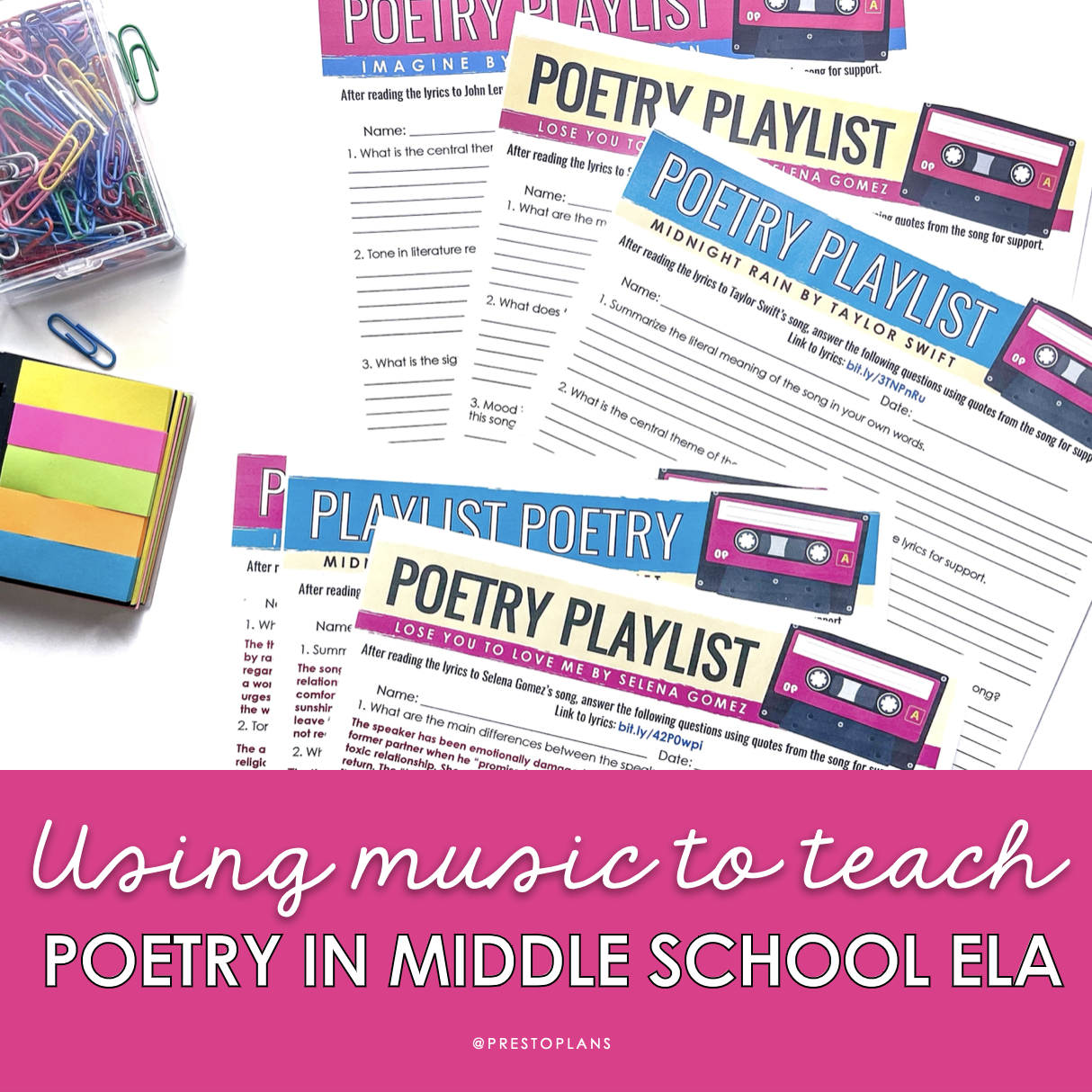
Using Music to Teach Poetry in ELA
Happy Poetry Month! Have you found that poetry can be a really complex topic for some middle and high school students? If so, you’re not alone! I used to really struggle to make poetry relevant to teenage students, but I think I’ve found the secret ingredient … music!
I find using music to teach poetry helps middle and high school students make connections between concepts from class and their personal interests. Who can say no to a catchy hook?! Music can also help bring complicated concepts, like figurative language, theme, and tone, to life for students. With this in mind, here are some of my favorite activities for using music to teach poetry in secondary ELA.
1. Literary Lyrics
When beginning any poetry unit, I find students benefit from some direct instruction as they review (or learn new!) figurative language terms. This is why I love the Literary Lyrics lesson to introduce a study of poetry!
First, I cue up my ready-to-use slides, which use current music lyrics to teach students about various literary devices used in poetry. From here, I work through each slide, reviewing terms like:
- Metaphor
- Simile
- Hyperbole
- Personification
- Alliteration
- … and more!
Engage students by including lyrics from artists such as Taylor Swift, Drake, Rihanna, John Legend, Billie Eilish, and any others that interest your students specifically. Once the lesson is over, students can apply their learning by identifying examples of figurative language in a variety of different song lyrics and explaining their thinking.
What I also really like about this presentation is that it can be edited or customized to suit your particular needs. This way, if you notice your students really love a specific artist who is not featured in the lesson, it’s easy to swap out one of the lyrics to appeal to your class! The presentation slides can also be printed in color and displayed as figurative language posters on your bulletin board!
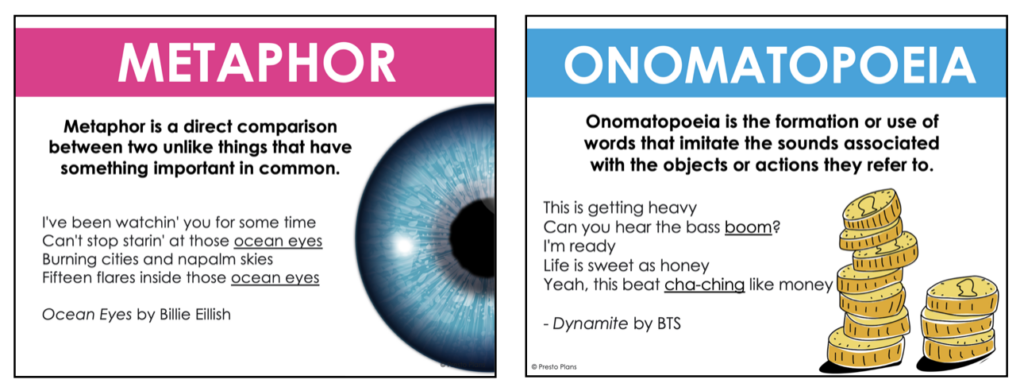
After students have learned about the different types of figurative language, I have them put this into practice by giving them examples of figurative language and having them label the type of device used in these literary lyrics assignments.
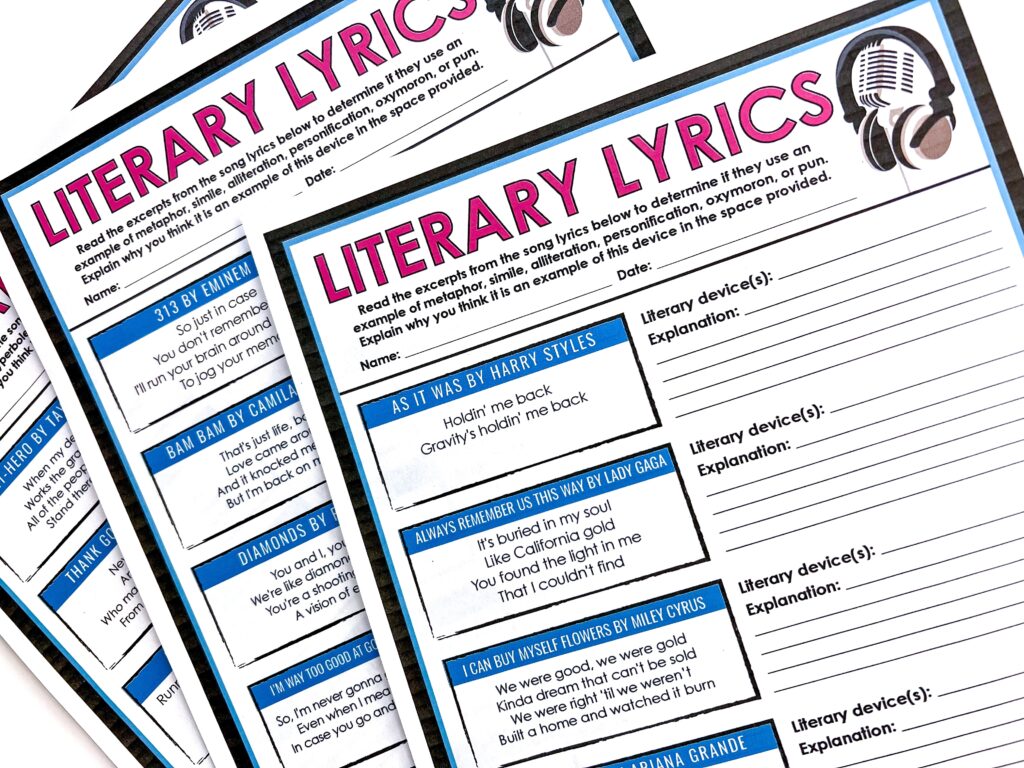
2. Musical Poetry Project
Once students have mastered the basic terminology, it’s time for them to put their skills into practice! If you’re using music to teach poetry, the ready-to-use Musical Poetry Project can be a great way to extend their understanding. In this learning task, students choose a song (appropriate for school, of course!) to analyze. As they closely read the lyrics, they will explore the song’s content and themes, as well as the literary devices used by the artist.
Detailed instructions and graphic organizers help students with two distinct stages of the assignment. In the first section, students must summarize and analyze the lyrics of the song. In addition to providing text evidence to support their analysis, students must also consider the relevance of the song’s title and thematic content. The second section requires students to identify specific literary devices and figurative language in their chosen song. A comprehensive five-point rubric is also provided for both sections of the assignment, which makes assessment a breeze!
What I love best about the Musical Poetry Project is that it incorporates student choice and voice. I find every middle or high school student learns best when they are able to connect their studies to their personal passions – and this assignment allows them to do exactly that! With music as the topic, you know they will be instantly engaged.
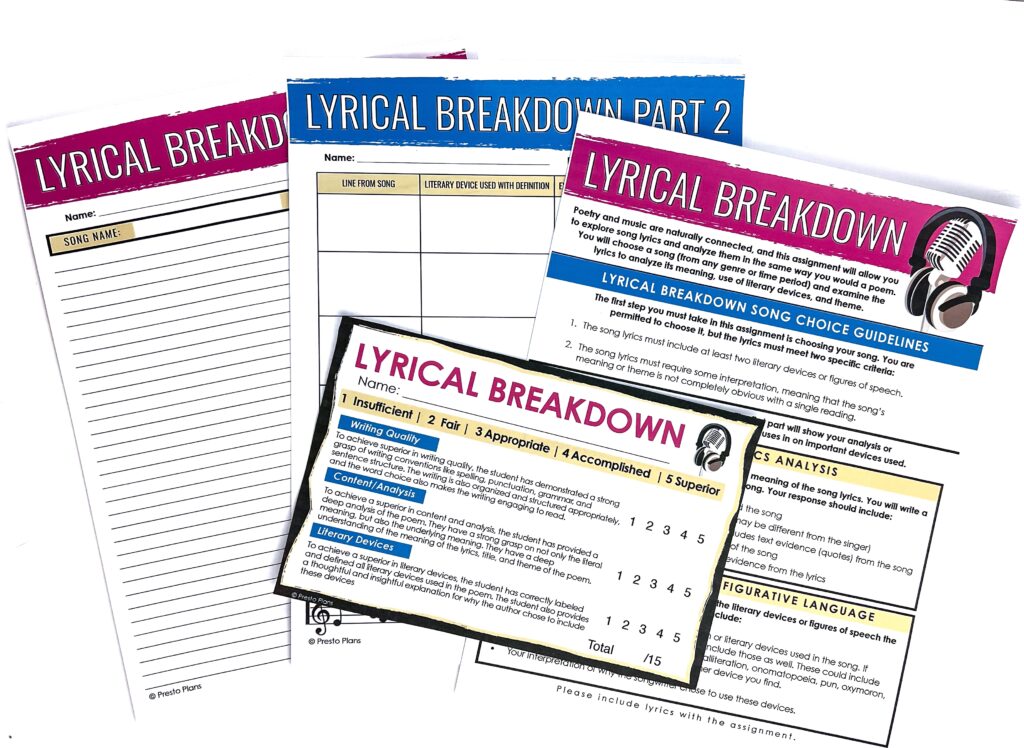
3. Soundtrack of My Life
One task I really enjoy when teaching poetry through music is the Soundtrack of My Life project. In this assignment, students consider which songs would be on the “soundtrack” of their lives, and why. What I especially love about this activity is the opportunity to get to know a little bit more about students’ personalities!
To begin, ask students to think of this assignment as a “mixtape” with ten songs on it (you might have to explain what a mixtape is!). First, set the tone by inviting them to consider the overall theme of the playlist. One trick I like to share is to imagine their life as a movie, with specific songs representing different years, or places. Or, they might like to put their own unique twist on the assignment! For example, they could select songs that reflect their various moods, hobbies, or interests.
Once students have focused their thoughts and chosen their ten songs, the next step is to explain their choices in writing. Using a graphic organizer, students share why they selected each song, and how it relates personally to their life. After everyone has completed their “mix,” I like to wrap up this activity by breaking students into small groups so they can share their soundtracks with each other! To make this activity visual, you can extend it by having students create album art for their soundtracks, and post them on your classroom community bulletin board.
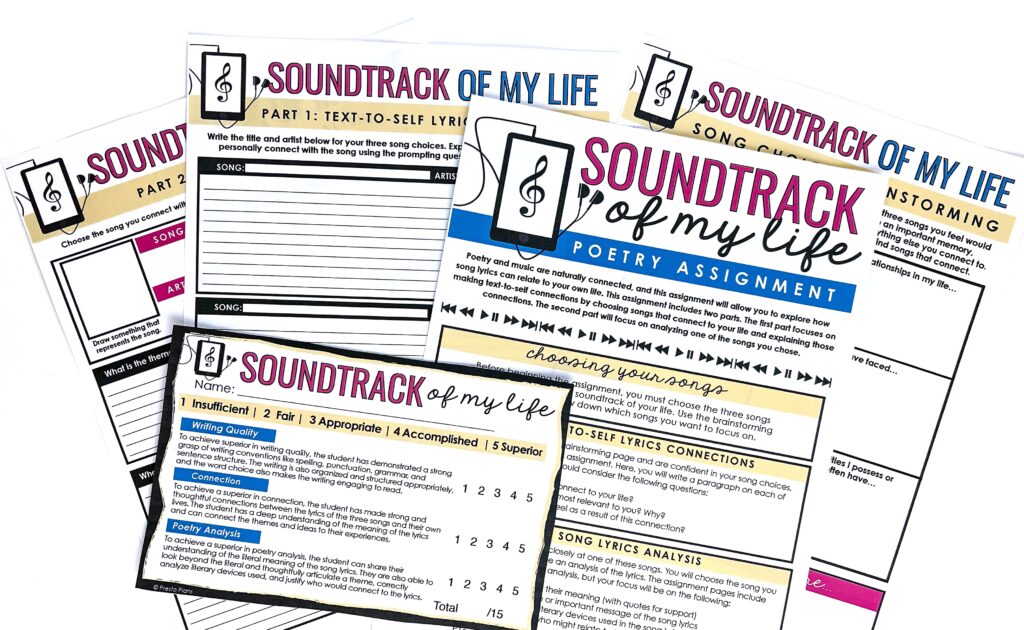
4. Rap Music Poetry Analysis
Using music to teach poetry doesn’t have to mean relying only on pop or country hits! Rap can provide another entry point for students to explore and analyze song lyrics as poetry. Your students might be surprised at how much rap and poetry have in common! From sophisticated rhyme and rhythm, literary devices, lyricism, storytelling, theme, social commentary, and emotional impact, poetry and rap have many similarities.
To begin, introduce the history of rap with a ready-to-use presentation, before sharing the main commonalities between poetry and rap. For each example, rap lyrics are provided to help students understand each concept. You can also use the video discussion prompts linked in the lesson to spark a lively whole-class or small-group activity.
From here, students can apply their learning as they compare Langston Hughes’ poem “Mother to Son” with Tupac Shakur’s song “Dear Mama.” Finally, they can wrap up this learning task by writing their own rap lyrics!
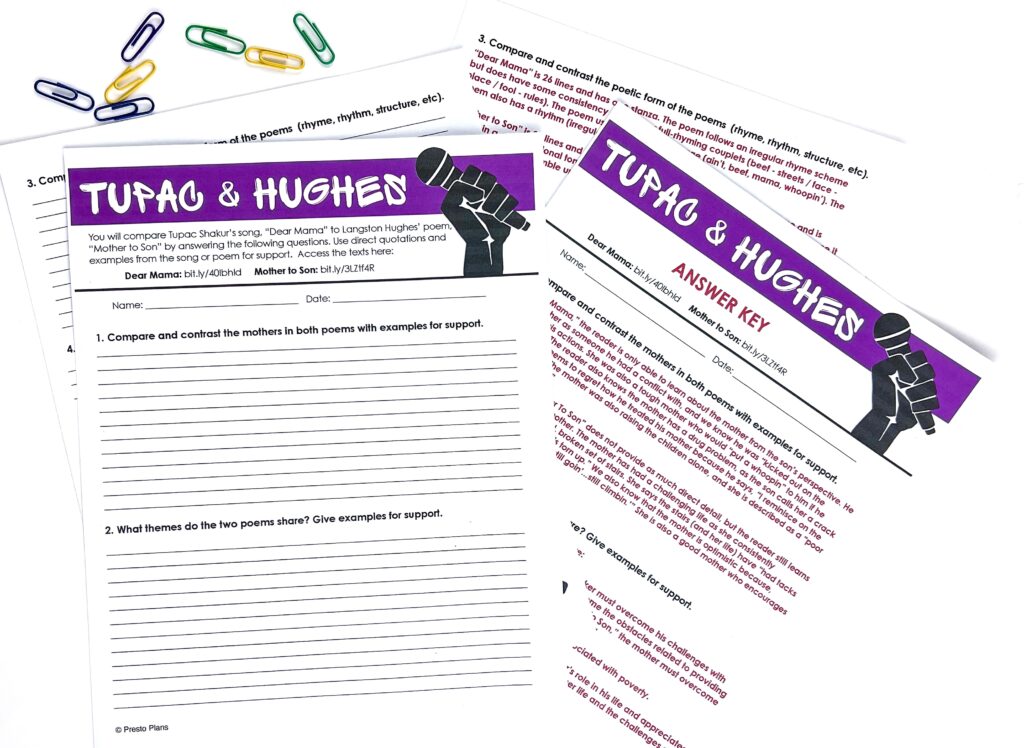
5. Poetry Playlist
When teaching poetry through music, students often benefit from collaborative opportunities to analyze lyrics and apply their understanding. I like to have students work in small groups on the Poetry Playlist task, which requires them to examine the lyrics of three songs and respond to a series of comprehension and analysis questions for each. The three songs include:
- “Imagine” by John Lennon
- “Midnight Rain” by Taylor Swift
- “Lose You to Love Me” by Selena Gomez
I like to organize this activity using the “snowball” format. Students analyze the first song in a group of four for a set period of time (I recommend 15 minutes to start, and you can adjust accordingly!). Once the time is up, they need to “snowball” and disperse into a new group of four to receive the second song. This can be repeated one final time for the third song to switch up the groups again!
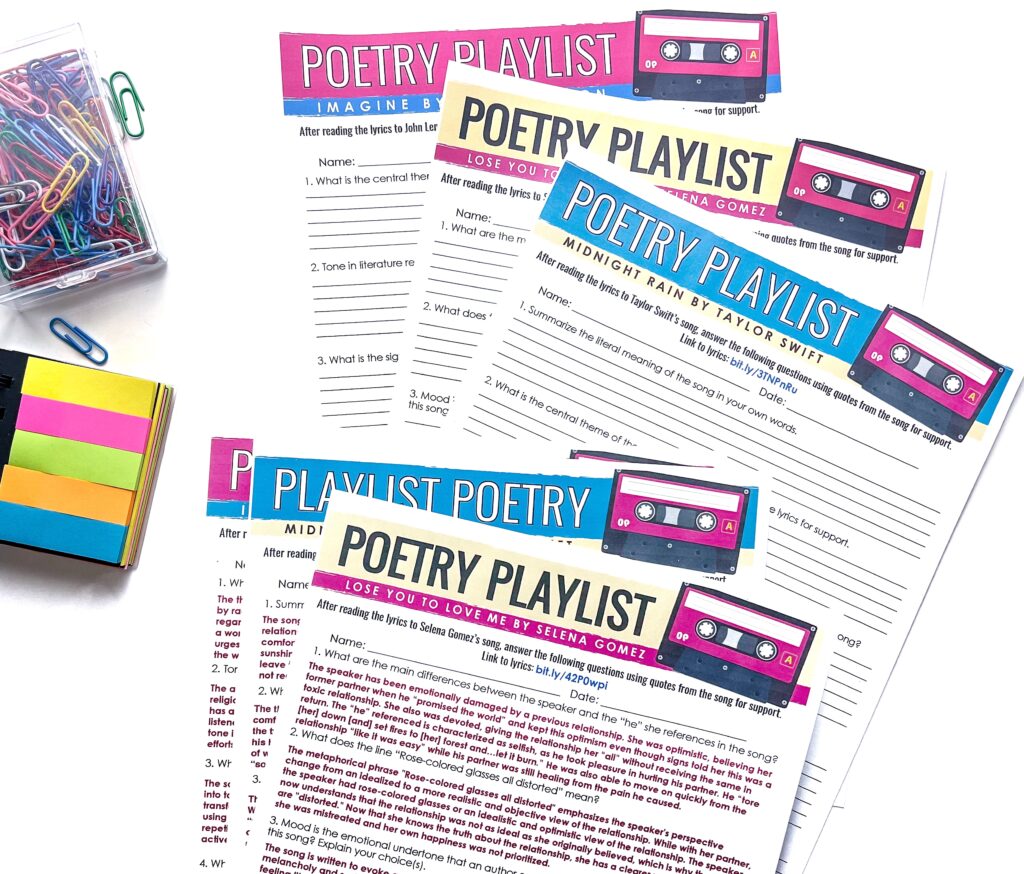
There you go! I hope these activities give you some fresh ideas for using music to teach poetry in ELA! All these lessons and activities are available in our discounted Musical Poetry bundle!
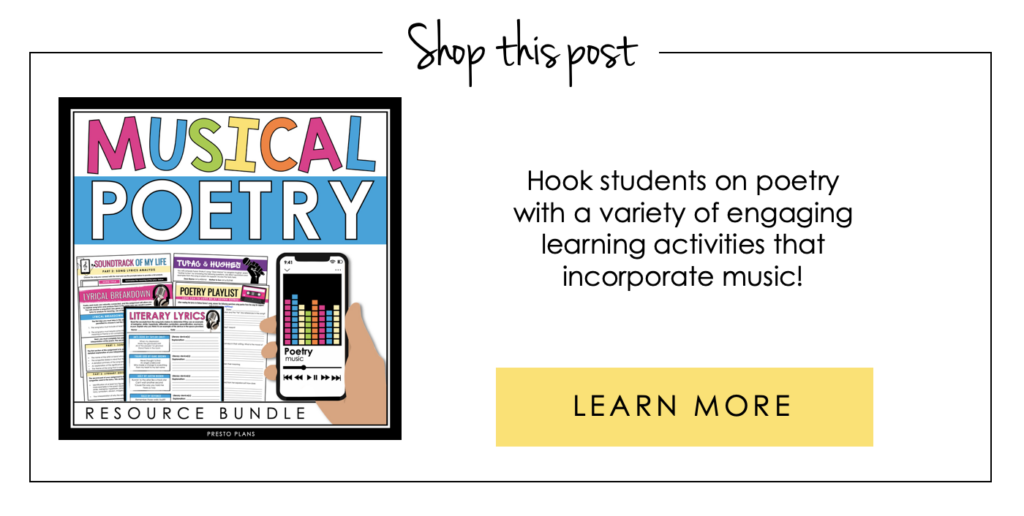
Looking for more ways to incorporate music into your poetry lessons? Check out my blog post on 10 Ways to Bring Music into the ELA Classroom.
You might also want to have a look at my 6-step plan for teaching figurative language in middle school!
Search the blog for what you are teaching
GIVEAWAYS
sent straight to your inbox!
share this post